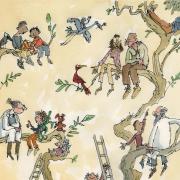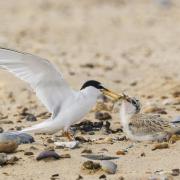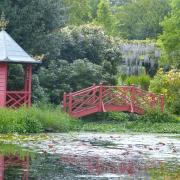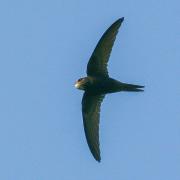A Suffolk nature lovers’ calendar to show you where and when you can see some of the county’s iconic wildlife throughout the year.

January
Banish those post-Christmas blues with a visit to the coast. A brisk walk along a Suffolk beach or estuary will revitalise the spirits and should provide a glimpse of some of our industrious waders probing the sand or mud flats for food. Wintering wildfowl are another highlight this month with tens of thousands of birds visiting East Anglia to escape the harsh winter in the frozen far North.

February
A late fall of snow in February is a timely reminder that we are still in winter but as the month progresses snowdrops appear, and nature prepares for warmer times ahead. The distinctive drum roll reverberating through a bare woodland landscape indicates the presence of a great spotted woodpecker. It’s not always easy to pinpoint the location of the drumming but scan the trees and eventually you should spot the bird through the leafless limbs. In the same woodland after nightfall the unmistakeable hoot of a male tawny owl may be heard and the hoarser call of a replying female as they prepare to nest.

March
It’s possible to see an adder above ground as early as February but March is when the reptile world really comes to life. The county has three other native species; the grass snake, slow worm and common lizard. All our reptiles are cold blooded, needing to bask in the sun to increase their body temperature before becoming fully active. So, checking south facing slopes on a warm and sunny morning could pay dividends if you love a sighting of a snake or lizard. Adders, although mildly venomous, are retiring by nature and not aggressive unless provoked. An adder bite can have serious health implications for a dog so when out looking for reptiles always keep dogs leashed.

April
Don’t miss out on a walk through a Suffolk bluebell wood this month, the scent of the flowers blooming en masse will hit you even before the visual spectacle comes into view. The timing of this ancient wonder varies from year to year so keep checking the development of the plants throughout April although they may not be in full bloom until next month. A glimpse of a roe deer or other wildlife amongst the flowers will be the icing on the cake.

May
This month the countryside seems awash with fledglings, tiny blue tits and masked long-tailed tits amongst the smaller species restlessly flittering from branch to branch. As many a human parent can confirm, just because they have flown the nest that doesn’t mean they won’t be hanging around hoping for a free meal. Parent starlings and blackbirds are harassed and harried by their begging youngsters as the adults scurry around trying to provide another meal for their brood. High up in an oak tree a movement amongst the branches may give away the presence of a roosting tawny owl fledgling, the owlet restlessly waiting for darkness to fall, with the promise of a vole or mouse from an overworked parent.

June
Damsels and dragons dominate my June highlight, but this is no fairytale. In summer the county’s ponds and wetlands abound with those ariel masters, damselflies and dragonflies. As they hover and chase their insect prey above the water, they themselves risk becoming predated by a dashing hobby. Amongst other invertebrates to look out for this month are stag beetles, butterflies and moths, you may even be lucky enough to spot a hyper-active hummingbird hawk moth pillaging the nectar from a buddleia on a sunny day.

July
As the harvest is gathered in fields that had contained tall, golden crops are now left bare with just the protruding stubble a reminder of their former glory. And yet the overspill from our harvest will tempt birds and animals to forage for leftovers with little cover to conceal them from prying eyes and lenses. “Mad March hare” is something of a misnomer, brown hares are scatty much of the year and with their breeding season continuing well into the summer you should be able to watch their madcap antics as they chase, leap and box amongst the stubble.

August
Take a picnic on a riverside walk and keep a pair of binoculars to hand, a sudden flash of iridescent blue along the riverbank announces the passing of a kingfisher. Keep it in sight until it lands, and your binoculars will reveal the spectacular colours in detail; electric blue, orange and white, the blue suddenly morphing to jade as the small bird turns in the bright sunlight.

September
A countryside fox is far more wary and secretive creature than its urban relative, so a daytime sighting is an encounter to savour. As this year’s cubs venture further from the den and the growing juveniles require increasing quantities of food it is possible to see inquisitive youngsters cautiously exploring the big, wide, world, usually with an adult in close attendance.

October
An autumn delight, the sights and sounds of the deer rut played out against a backdrop of russet leaves and misty heaths. The sound of a large red deer stag bellowing as he patrols his stamping ground is awe inspiring and if you are fortunate enough to witness two of these beasts lock antlers it will be a truly unforgettable experience. Smaller fallow deer bucks are also strutting their stuff now with the palmate antlers of a big adult male just as impressive as the armoury of the red deer stag.

November
As autumn runs headlong into winter and with fewer prey species available, tough times lie ahead for our birds of prey. This year’s fledglings, lacking the experience of the adult birds, will have to spend more time hunting making November a productive month for raptor spotting. Juvenile kestrels can be seen hovering over open grassland including parks, fields and road verges. After a few unsuccessful dives they may have to resort to observing from a fence post or similar perch to conserve energy. Common buzzards can adopt a similar sit and wait strategy but will not pass up the opportunity to feed on carrion including roadkill that they have spotted with their acute eyesight whilst gliding high above the tree line.

December
During winter’s lean months garden birds are supplementing their natural diet with the food we provide on bird tables and in hanging feeders so why not spend some time enjoying these visitors from the comfort of your armchair. Starlings, house sparrows, robins and several tit species may be joined by chaffinches, fieldfares or a nuthatch. The comings and goings of so many small birds may attract the attention of a handsome male sparrowhawk and a sudden arial ambush will send them darting for cover.



























